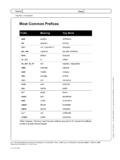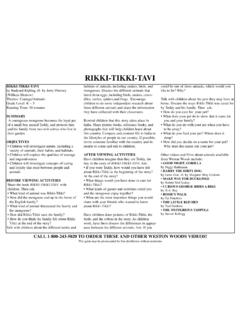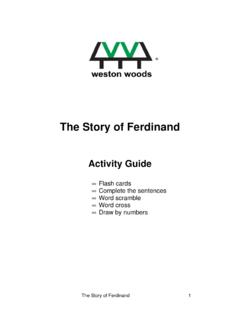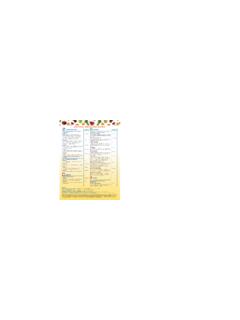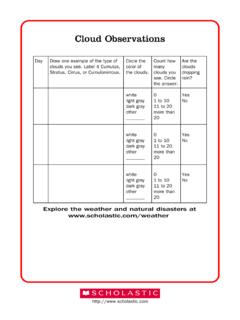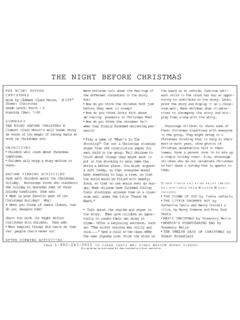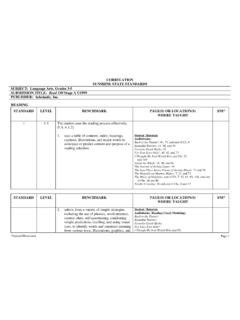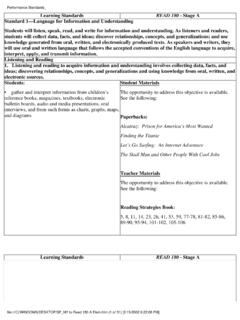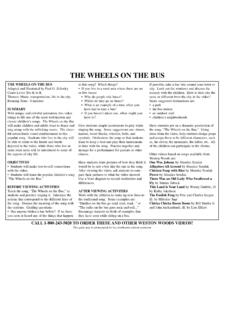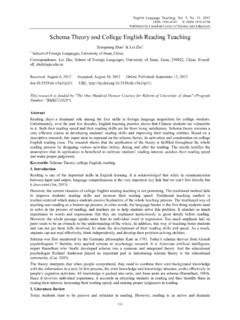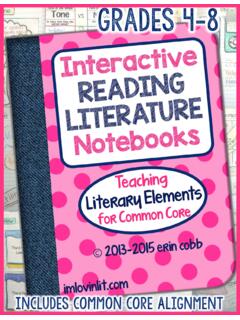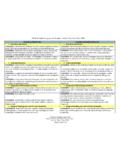Transcription of Common Core State Standards Grade 3 SCHOLASTIC GUIDED ...
1 Common Core State Standards Grade 3 SCHOLASTIC GUIDED reading TEXT types . reading : literature Each teacher card includes Making Connections, Developing Comprehension: Thinking Key Ideas and Details Within the Text, Thinking Beyond the Text, Thinking About the Text, and Oral 1. Ask and answer questions to demonstrate understanding of a text, Language/Conversation. These features encourage teachers and students to engage referring explicitly to the text as the basis for the answers. in meaningful dialogue about the selected title using a question & response format. 2. Recount stories, including fables, folktales, and myths from diverse Students are encouraged to use a variety of comprehension strategies to participate in cultures; determine the central message, lesson, or moral and explain active reading .
2 How it is conveyed through key details in the text. In addition, the following titles include further activities: 3. Describe characters in a story ( , their traits, motivations, or J: Have You Seen Duck? (Developing Comprehension: Understanding Character). feelings) and explain how their actions contribute to the sequence of J: Log Hotel (Developing Comprehension: Understanding Sequence). events. J: Story County (Developing Comprehension: Recognizing Story Sequence). J: Young Cam Jansen and the Baseball Mystery (Developing Comprehension: Generating Questions). K: Andy Shane and the Queen of Egypt (Developing Comprehension: Understanding Character). K: Dandelions: Stars in the Grass (Developing Comprehension: Recognizing Sequence).
3 K: Earl the Squirrel (Developing Comprehension: Understanding Plot). K: Frog and Toad All Year (Developing Comprehension: Summarizing). K: One Nosy Pup (Developing Comprehension: Understanding Problem and Solution). L: Cam Jansen and the Chocolate Fudge Mystery (Developing Comprehension: Problem and Solution). L: Stand Tall, Molly Lou Melon (Developing Comprehension: Understanding Theme). L: The Subway Mouse (Developing Comprehension: Understanding Problem and Solution). M: Class President (Developing Comprehension: Understanding Character). N: Blizzard of the Blue Moon (Developing Comprehension: Understanding Plot). N: Detective LaRue: Letters from the Investigation (Developing Comprehension: Making Inferences).
4 O: Otis Spofford (Developing Comprehension: Understanding Character). O: Teacher's Pet (Developing Comprehension: Understanding Plot). O: You Can't Taste a Pickle With Your Ear (Developing Comprehension: Summarizing). P: Gooseberry Park (Developing Comprehension: Summarizing). Q: Shrek! (Developing Comprehension: Understanding Character). Q: Stallion in Spooky Hollow (Developing Comprehension: Recognizing Setting). Q: The Tale of Anton Brown and Grace Hopper (Developing Comprehension: Identifying Plot). Craft and Structure J: Have You Seen Duck? (Developing Phonics and Word-Solving Strategies: Dialogue). 4. Determine the meaning of words and phrases as they are used in a J: Story County (Developing Phonics and Word-Solving Strategies: Dialogue).
5 Text, distinguishing literal from non-literal language. K: Andy Shane and the Queen of Egypt (Developing Phonics and Word-Solving 5. Refer to parts of stories, dramas, and poems when writing or speaking Strategies: Multiple-Meaning Words). about a text, using terms such as chapter, scene, and stanza; describe K: The Principal from the Black Lagoon (Developing Comprehension: Recognizing how each successive part builds on earlier sections. Point of View). 6. Distinguish their own point of view from that of the narrator or those L: Amelia Bedelia, Rocket Scientist? (Developing Phonics and Word-Solving Page 40. Common Core State Standards Grade 3 SCHOLASTIC GUIDED reading TEXT types . of the characters. Strategies: Multiple-Meaning Words).
6 L: Tony Baloney (Developing Phonics and Word-Solving Strategies: Understanding Idioms). L: Whales Passing (Developing Comprehension: Recognizing Point of View). N: The Phantom Mudder (Developing Comprehension: Understanding Point of View). P: Copper Developing Comprehension: Understanding Text Structure). Integration of Knowledge and Ideas This collection includes titles from Levels J-Q that represent a variety of genres 7. Explain how specific aspects of a text's illustrations contribute to including: Biography, Realistic Fiction, Mystery, Science Fiction, Fantasy, Graphic what is conveyed by the words in a story ( , create mood, emphasize Novel, Fairy Tale/Folktale, Play, Adventure, and Informational Text. aspects of a character or setting).
7 8. (Not applicable to literature ) This collection also includes titles from a variety of series, for example: 9. Compare and contrast the themes, settings, and plots of stories written J: Henry and Mudge and the Best Day of All by the same author about the same or similar characters ( , in books K: Andy Shane and the Queen of Egypt from a series). L: Cam Jansen and the Chocolate Fudge Mystery M: Flat Stanley N: Detective LaRue: Letters from the Investigation O: Clementine P: The Magic School Bus Explores the Senses Q: Book Two: The Stonekeeper's Curse Range of reading and Complexity of Text This collection includes titles from Levels J-Q that represent a variety of genres and the end of the year, read and comprehend literature , including difficulty levels.
8 Each title includes a teacher card outlining support activities for that stories, dramas, and poetry, at the high end of the grades 2 3 text text. complexity band independently and proficiently. reading : Informational Text Each teacher card for the following Nonfiction and Informational texts includes Making Key Ideas and Details Connections, Developing Comprehension: Thinking Within the Text, Thinking Beyond 1. Ask and answer questions to demonstrate understanding of a text, the Text, Thinking About the Text, and Oral Language/Conversation. Each of these referring explicitly to the text as the basis for the answers. features encourages teachers and students to engage in meaningful dialogue about 2. Determine the main idea of a text; recount the key details and explain informational text using a question & response format.
9 Students are encouraged to use how they support the main idea. a variety of comprehension strategies to participate in active reading . 3. Describe the relationship between a series of historical events, scientific ideas or concepts, or steps in technical procedures in a text, J: Dig Dig Digging using language that pertains to time, sequence, and cause/effect. J: Log Hotel K: Dandelions: Stars in the Grass K: Endangered Animals L: Let's Read About George Washington L: Our Earth M: Baby Animals M: Who Eats What? Food Chains and Food Webs N: Sacajawea: Her True Story N: Young Frederick Douglass: Freedom Fighter O: Amelia Earhart: Adventure in the Sky O: What's the Big Idea, Ben Franklin? O: You Can't Taste a Pickle With Your Ear Page 41.
10 Common Core State Standards Grade 3 SCHOLASTIC GUIDED reading TEXT types . P: The Magic School Bus Explores the Senses P: My First Book of Biographies: Great Men and Women Every Child Should Know Q: All About Manatees Q: Finding the Titanic In addition, the following titles include further activities: J: Dig Dig Digging (Developing Comprehension: Understanding Genre: Informational Text). K: Dandelions: Stars in the Grass (Developing Comprehension: Recognizing Sequence). K: Endangered Animals (Developing Comprehension: Understanding Cause and Effect). L: Let's Read About George Washington (Developing Comprehension: Understanding Historical Context). L: Our Earth (Developing Comprehension: Noticing Details). M: Who Eats What?
